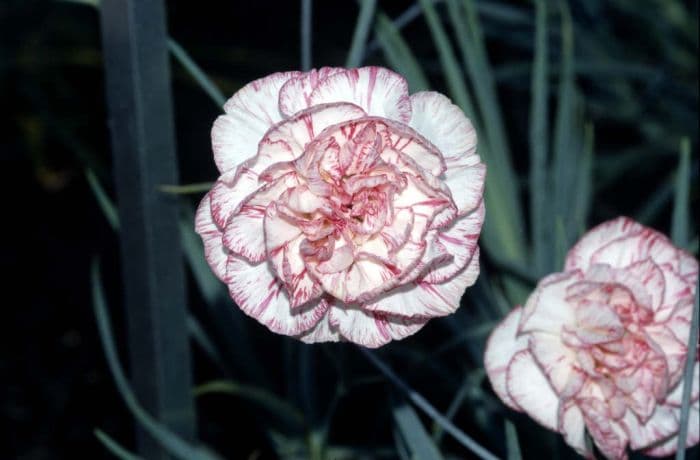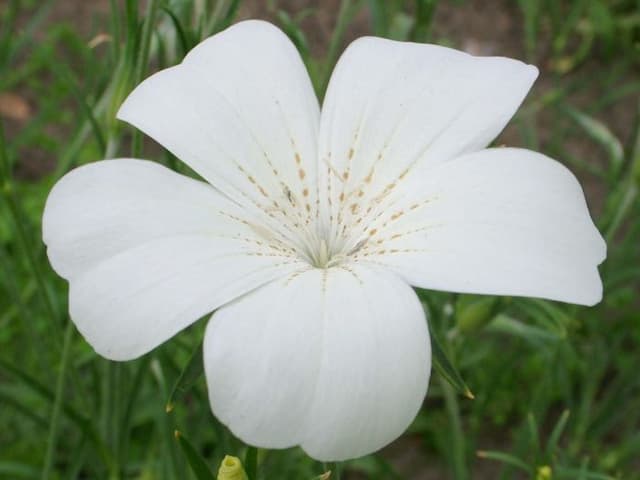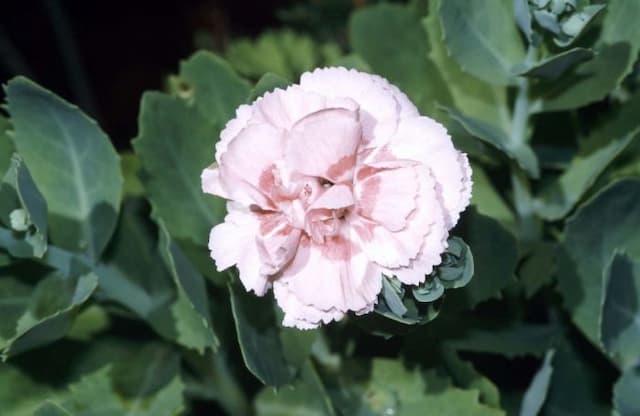Sweet William Dianthus 'John Sandall' (b)

ABOUT
Dianthus 'John Sandall' is a vibrant and attractive plant known for its beautiful blooms and sweet fragrance. Its flowers are a standout feature, typically exhibiting a radiant pink hue with distinctive fringed petals, which can sometimes display a lighter or white edge, giving them a frothy appearance. The center of the flowers often shows a deeper pink or red eye, providing a lovely contrast to the lighter petal edges. These blooms sit atop slender, sturdy stems, which are surrounded by a mound of narrow, lance-shaped leaves. The foliage is typically blue-green or grayish-green, forming a dense, grassy clump that serves as a lush backdrop to the striking flowers. The leaves' texture may appear somewhat grass-like, adding to the overall delicate yet full-bodied structure of the Dianthus. This plant exudes a spicy, clove-like scent that is particularly intense in the early morning and evening, making it a delightful addition to any garden space that seeks to engage the senses.
About this plant
 Names
NamesSynonyms
Carnation, Pink
Common names
Dianthus 'John Sandall'.
 Toxicity
ToxicityTo humans
The Dianthus 'John Sandall', more commonly referred to as Carnation, is generally not considered toxic to humans. Ingesting parts of this plant is unlikely to result in serious poisoning. However, it's always possible for individuals to have allergies or sensitivities to the plant, potentially causing mild irritation or discomfort if ingested or handled without care.
To pets
Carnations are considered to be mildly toxic to pets. If ingested by a cat or dog, the plant may cause gastrointestinal upset, including symptoms like vomiting and diarrhea. It's important to keep an eye on pets and seek veterinary care if they consume a significant amount of the plant or exhibit severe reactions.
 Characteristics
CharacteristicsLife cycle
Perennials
Foliage type
Evergreen
Color of leaves
Green
Flower color
Pink
Height
10 inches (25 cm)
Spread
12 inches (30 cm)
Plant type
Herb
Hardiness zones
7
Native area
Europe
Benefits
 General Benefits
General Benefits- Attractive Flowers: Dianthus 'John Sandall,' commonly known as Carnation or Pink, has showy and often fragrant flowers that add aesthetic appeal to gardens and landscapes.
- Long Blooming Period: Carnations can have a long flowering season, providing color and interest in the garden for an extended time.
- Drought Tolerance: Once established, Carnations are relatively drought-tolerant, making them suitable for gardens in drier climates or for water-conserving landscapes.
- Low Maintenance: The Carnation is known for being easy to care for, requiring minimal maintenance once it is settled in its growing conditions.
- Versatility: Carnations can be used in a variety of garden settings, including borders, rockeries, and containers, adding versatility to garden design.
- Pollinator Friendly: The flowers of the Carnation can attract bees and other pollinators, supporting local ecosystems and biodiversity.
- Cut Flowers: Carnations are popular as cut flowers, with a long vase life, making them ideal for floral arrangements and bouquets.
- Variety of Colors: Available in a wide range of colors, Carnations can be used to create vibrant color schemes in garden beds and floral designs.
- Deer Resistant: Carnations are generally resistant to deer, making them a good choice for gardens frequented by wildlife.
 Medical Properties
Medical PropertiesThis plant is not used for medical purposes.
 Air-purifying Qualities
Air-purifying QualitiesThis plant is not specifically known for air purifying qualities.
 Other Uses
Other Uses- Dye Production: The petals of the Dianthus 'John Sandall' can be used to create a natural dye for fabrics or paper, resulting in a variety of pinkish hues depending on the mordant used.
- Culinary Garnish: The flowers of the Sweet William can be used as an ornamental garnish for desserts and salads, adding a pop of color and a mild spicy taste.
- Bookmark Creation: Dry and press the flowers of Sweet William to make decorative bookmarks, preserving their beauty in a functional way.
- Plant Potpourri: Dried flowers and leaves of Sweet William can be added to potpourri mixes for a natural and subtle fragrance in your home.
- Artistic Inspiration: Artists can use the vibrant colors and patterns of Sweet William flowers as a subject for botanical illustrations or paintings.
- Sachets and Drawer Fresheners: Dried Sweet William flowers can be sewn into small sachets and placed in drawers or closets to impart a gentle fragrance to linens and clothing.
- Scented Letters: Sprinkle dried petals of Sweet William in envelopes to add an unexpected and delightful scent to correspondence.
- Bath Additives: Fresh or dried petals can be added to bathwater for a visually appealing and softly scented bathing experience.
- Floral Ice Cubes: Freeze small flowers of Sweet William in ice cubes to create an elegant touch for summer drinks and cocktails.
- Candle Embedding: Embed dried Sweet William petals in homemade candles for decorative flair and to add a faint scent when the candle burns.
Interesting Facts
 Feng Shui
Feng ShuiThe Carnation is not used in Feng Shui practice.
 Zodiac Sign Compitability
Zodiac Sign CompitabilityThe Carnation is not used in astrology practice.
 Plant Symbolism
Plant Symbolism- Love: As a member of the Dianthus family, this plant is often associated with love and affection, given its traditionally vibrant and attractive flowers.
- Admiration: The Dianthus 'John Sandall' is admired for its beauty and resilience, symbolizing deep admiration for someone.
- Purity: The flower's brightness and clarity can represent purity and innocence.
- Boldness: The striking appearance of the Dianthus 'John Sandall' signifies boldness and the courage to stand out.
- Devotion: Historically, Dianthus flowers are connected with devotion due to their long-lasting bloom, emblematic of a long-term committed relationship.
 Water
WaterThe Sweet William plant prefers consistent moisture with adequate drainage, so it's crucial to water it thoroughly when the top inch of soil feels dry to the touch. As a general guide, water the Sweet William around once a week, but this can vary depending on climate conditions. During summer or in hot climates, it may require watering twice a week. When watering, apply approximately one gallon of water to thoroughly soak the root zone. Adjust watering frequency and volume based on rainfall, temperature, and soil type, decreasing water in cooler seasons or when rain is abundant.
 Light
LightSweet William thrives best in full sun to partial shade conditions. This means it needs to be placed in a spot where it can receive at least six hours of direct sunlight daily. However, it can also tolerate some afternoon shade, especially in hotter regions, which can help protect it from intense, midday sun.
 Temperature
TemperatureSweet William plants are cold-hardy and can survive temperatures down to about 20 degrees Fahrenheit, but they grow best between 60 to 70 degrees Fahrenheit. They can endure short periods of higher temperatures but prefer cooler conditions, making them suitable for spring and fall blooms. Prolonged heat above 80 degrees Fahrenheit can stress the plants and may reduce flowering.
 Pruning
PruningPruning Sweet William plants promotes bushier growth and encourages more flowers. Deadhead spent blooms regularly to prevent the plant from going to seed, which can extend the blooming period. After the main bloom in late spring or early summer, cut the plant back by one-third to rejuvenate it for a potential second flush of flowers in the fall. The best time to prune for shaping is in the spring just as new growth starts to appear.
 Cleaning
CleaningAs needed
 Soil
SoilCarnations prefer well-draining, loamy soil with a neutral to slightly alkaline pH, typically between 6.6 to 7.5. To create the best soil mix, combine two parts loam, one part sand, and one part compost to ensure good drainage and fertility.
 Repotting
RepottingCarnations need to be repotted every 2 to 3 years or when they outgrow their current container. Ensure that the new pot is only slightly larger than the old one to prevent excess soil moisture.
 Humidity & Misting
Humidity & MistingCarnations thrive in average humidity levels. They do well in typical outdoor atmospheres and do not require high humidity environments to flourish.
 Suitable locations
Suitable locationsIndoor
Place carnations in bright, indirect light and well-draining soil indoors.
Outdoor
Plant carnations in full sun, well-draining soil, protect from strong winds.
Hardiness zone
3-9 USDA
 Life cycle
Life cycleThe life of Dianthus 'John Sandall', also known as Sweet William, begins with seed germination, which typically occurs in late winter or early spring when soil temperatures warm sufficiently. Following germination, seedlings develop a rosette of leaves at the soil level as they enter the vegetative growth stage. As the plant matures, it develops a sturdy stem and begins to produce its distinctive clusters of fragrant flowers, usually in late spring to early summer, depending on the climate. After pollination, which is often facilitated by insects attracted to the flowers' vivid colors and sweet scent, the plant produces small capsule-like fruits containing seeds. When the seeds are mature, they are dispersed by wind, water, or animal activity, completing the reproductive cycle. The plant is a short-lived perennial or biennial, meaning it may live for several years, but typically it is cultivated as an annual or biennial, completing its full life cycle from seed to seed in one or two growing seasons respectively.
 Propogation
PropogationPropogation time
Spring to Summer
Dianthus 'John Sandall', commonly known as pinks, is often propagated through cuttings, which is the most popular method for this ornamental plant. For successful propagation, the best time is late spring to early summer when the plant is growing vigorously. Stem cuttings about 4 to 6 inches long, with the lower leaves removed, can be taken from non-flowering shoots. The cut end should be dipped in rooting hormone powder to enhance root development and then placed in a well-draining potting mix. It's important to maintain a high humidity environment, which can be done by covering the cutting with a plastic bag or placing it in a propagator. Roots typically form within two to three weeks, after which the new plants can be gradually acclimatized to outdoor conditions before transplanting.








![Pink [Bubblegum]](/_next/image?url=https%3A%2F%2Fplants-admin.emdemapps.com%2Fimages%2Fplants%2F%2Fimages%2F604b596f31cbb.png&w=640&q=75)
